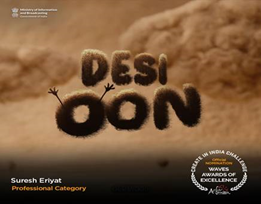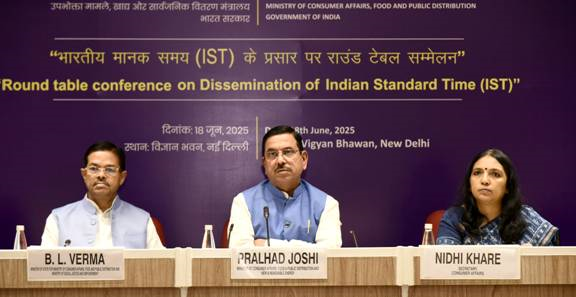Topic- 1: Nainital to Highlight Climate Change and Atmospheric Observations from the Himalayas
GS-3: Economy
The context:
An international meeting on climate change and atmospheric sciences was held from June 16–20, 2025, at Aryabhatta Research Institute of Observational Sciences (ARIES), Nainital, under the Department of Science & Technology (DST), Government of India. The event brought together global experts from the NDACC-IRWG, TCCON, and COCCON networks, focusing on FTIR (Fourier Transform Infrared) spectroscopy-based ground observations of greenhouse gases.
The Key Highlights:
-
- Global atmospheric science experts gathered at Nainital to assess changes in greenhouse gases and their implications for climate change.
- The meeting underscored the significance of FTIR spectroscopy-based ground observations, particularly in ecologically sensitive Himalayan regions.
- The Aryabhatta Research Institute of Observational Sciences (ARIES), under the Department of Science & Technology (DST), hosted the event at its Manora Peak campus.
- The meeting brought together three major international networks—NDACC-IRWG, TCCON, and COCCON—focused on atmospheric composition change.
- The former ISRO chairman and current chair of ARIES’ governing body inaugurated the event and emphasized the complementary role of space-based monitoring.
- It was highlighted that space-based observations are not sufficiently effective over the Himalayan region, reinforcing the need for enhanced ground-based monitoring.
- India currently has limited FTIR-based observational infrastructure, and experts called for its expansion to improve regional climate understanding.
- Approximately 70 participants, including 47 international delegates from over 10 countries, took part in the meeting held in a hybrid format.
- The meeting facilitated collaboration and knowledge-sharing among international atmospheric research communities, especially on carbon and trace gas measurements.
Source: PIB
Topic- 2: ‘Desi Oon’ Puts Indian Animation on Global Stage
GS-3: Economy
The context:
India’s animation industry received a major global boost as Desi Oon, an animated film by renowned filmmaker Suresh Eriyat, won the Jury Award for Best Commissioned Film at the Annecy International Animation Festival 2025, France — widely considered the world’s most prestigious animation stage.
About the ‘Desi Oon’:
-
- ‘Desi Oon’, an animated film by Shri Suresh Eriyat, won the Jury Award for Best Commissioned Film at the prestigious Annecy International Animation Festival 2025 in France.
- The film is a flagship success story from the Create in India Challenge, launched by the Ministry of Information & Broadcasting under WAVES 2025 to promote India’s AVGC-XR sector.
- ‘Desi Oon’ was also crowned Best Film at the WAVES Awards of Excellence 2025, India’s premier platform for honouring achievements in animation and design.
- It has been shortlisted for the Cannes Lions 2025 in the Film Craft Lions category, marking a historic recognition for Indian animation on the global advertising stage.
- The Create in India Challenge attracted entries from over 60 countries, spotlighting culturally rooted Indian stories powered by technology, with 750 finalists showcased at Creatosphere, WAVES 2025.
- Studio Eeksaurus and Suresh Eriyat also earned accolades including a win at the 2025 AICP Show, ensuring the film’s inclusion in the archives of MoMA, New York.
- The film bagged 2 Golds at Good Ads Matter 2025 for Best Animation Film and Best Animation + CGI Integration.
- At the Kyoorius Creative Awards, ‘Desi Oon’ won 2 Blue Elephants and 1 Baby Black Elephant, further proving its creative impact.
- It was also honoured with the prestigious D&AD Wooden Pencil, celebrating excellence in global advertising design.
- Described as a cultural milestone, ‘Desi Oon’ blends Indian ethos with global appeal, inspiring a new generation of Indian creators to think big and tell rooted stories with global resonance.

About WAVES Awards of Excellence:
-
- It was organized by the Ministry of Information & Broadcasting in collaboration with ASIFA India, WAVES honours the best in Animation, VFX, Design, and Emerging Media, celebrating the diversity and potential of India’s creative landscape.
About ASIFA India:
-
- The Indian chapter of ASIFA International, a UNESCO-supported global body, ASIFA India is dedicated to the art of animation and fosters creative exchange, capacity building, and recognition through festivals, talks, mentorships, and awards.
Source: PIB
Topic- 3: Mizoram Signs MoU with Digital India BHASHINI for Multilingual and Inclusive Governance
GS-3: Economy
The context:
In a major step towards inclusive digital governance and linguistic empowerment, the Government of Mizoram signed a Memorandum of Understanding (MoU) with the Digital India BHASHINI Division (DIBD) under the Ministry of Electronics and Information Technology (MeitY) on June 18, 2025. The agreement promotes the use of native languages, including Mizo dialects, in digital governance.
The Key Highlights:
-
- The Government of Mizoram and Digital India BHASHINI Division (DIBD) signed an MoU on June 18, 2025, to enable multilingual governance and promote digital inclusion in native Mizo languages.
- This collaboration aims to empower tribal communities by integrating BHASHINI’s language technology into governance systems, ensuring access to digital services in local dialects.
- The partnership supports Mizoram’s commitment to preserving its linguistic heritage while fostering inclusive digital transformation.
- Senior officials from MeitY and the Government of Mizoram emphasized that the initiative will make governance culturally sensitive, citizen-centric, and technologically inclusive.
- BHASHINI and Mizoram will co-create technology solutions that align with the linguistic and cultural fabric of the state, marking a model for inclusive digital governance in India.
The strategic partnership aims to achieve
-
- Enhanced Citizen Services – By enabling access to government schemes, services, and information in Mizo and other local languages.
- Inclusive Governance – By breaking language barriers in public administration, the initiative promotes transparency, trust, and participation from all sections of society.
- Digital Empowerment – The partnership ensures that no citizen is left behind due to language limitations, making technology and governance truly accessible and inclusive.
- Improve Mizo Language AI Models – Collaborate on enhancing Mizo language datasets and AI models to create accurate, culturally relevant translation tools for India’s multilingual ecosystem.
What is Bhashini Platform?
-
- BHASHINI, or the BHASHa INterface for India, is India’s Artificial Intelligence (AI)-led language translation platform, breaking down language barriers and enabling conversations between speakers of different Indian languages.
- It aims to enhance internet accessibility and digital services in Indian languages, incorporating voice-based functions and promoting content creation in diverse languages.
- Launched in July 2022 under the National Language Translation Mission (NLTM), BHASHINI aims to provide technology translation services in 22 scheduled Indian languages.
- It aims to make Artificial Intelligence and Natural Language Processing (NLP) resources available in the public domain to be used by Indian MSMEs, startups, and individual innovators.
- BHASHINI is implemented by the Digital India BHASHINI Division, a division under the Digital India Corporation, a Section 8 Company of the Ministry of Electronics and Information Technology.
- The platform is accessible through dedicated Android and iOS apps, providing a user-friendly experience.
- This online platform also has a separate ‘Bhasadaan’ section which allows individuals to contribute to multiple crowdsourcing initiatives.
Source: PIB
Topic- 4: INS Arnala Commissioned into Indian Navy: First Indigenous Anti-Submarine Shallow Water Craft
GS-3: Science and Technology
The context:
INS Arnala, the first of 16 indigenously built Anti-Submarine Warfare Shallow Water Craft (ASW-SWC), was commissioned into the Eastern Naval Command on June 18, 2025, at Visakhapatnam.
The Key Highlights:
-
- The commissioning ceremony was held in the presence of Chief of Defence Staff and attended by senior naval officers and representatives from GRSE and L&T Shipbuilding.
- INS Arnala is designed for sub-surface surveillance and interdiction, search and rescue operations, and Low-Intensity Maritime Operations (LIMO).
- The warship spans 77 meters in length, weighs over 1,490 tonnes, and is the largest Indian naval vessel propelled by a Diesel Engine–Waterjet combination.
- It is equipped with state-of-the-art Anti-Submarine Warfare weapons and advanced sensor suites, enhancing the Navy’s operational capabilities in shallow waters.
- The vessel marks a significant leap in India’s push for indigenous defence production, showcasing advanced design, engineering, and manufacturing capabilities.
- The Chief of Defence Staff praised the Indian Navy’s transformation from a “Buyer’s Navy” to a “Builder’s Navy,” underscoring the vision of maritime self-reliance.
- India now has a large number of capital warships and auxiliary vessels under indigenous construction, aligning with its Blue Water Navy aspirations.
About the INS Arnala:
-
- ‘Arnala’ is the first of eight indigenously built Anti-Submarine Warfare Shallow Water Crafts (ASW SWCs) delivered to the Indian Navy recently.
- It was designed and built by Garden Reach Shipbuilders and Engineers (GRSE), Kolkata, and constructed at M/s L&T Shipyard, Kattupalli, under a Public-Private Partnership (PPP).
- The warship was built according to the Indian Register of Shipping (IRS) classification rules, showcasing adherence to domestic naval architecture standards.
- The project reflects the successful collaboration between the public and private sectors in India’s defence manufacturing ecosystem, supporting strategic self-reliance.
- ‘Arnala’ is named after the historic Arnala Fort located off Vasai, Maharashtra, symbolising India’s rich maritime legacy and heritage.
- The vessel is 77 metres long and holds the distinction of being the largest Indian Naval warship powered by a Diesel Engine-Waterjet propulsion system.
Primary roles of the ship include:
-
- Underwater surveillance in coastal zones
- Search and Rescue (SAR) operations
- Low Intensity Maritime Operations (LIMO)
- Coastal Anti-Submarine Warfare (ASW) operations
- Advanced mine-laying capabilities.
The induction of ASW SWCs like Arnala significantly enhances India’s shallow water anti-submarine warfare capacity, vital for maritime security in littoral zones.
Over 80% of the ship’s components are sourced indigenously, marking a major step in the realization of ‘Aatmanirbhar Bharat’ in defence manufacturing.
Source: PIB
Topic- 5: One Nation, One Time initiative and the Legal Metrology (Indian Standard Time) Rules, 2025
GS-3: Science and Technology
The context:
The Department of Consumer Affairs, Government of India, organized a landmark Round Table Conference on Time Dissemination at Vigyan Bhawan, New Delhi, 18th June 2025, under the visionary theme “One Nation, One Time.”
Union Minister for Consumer Affairs, Food & Public Distribution and New & Renewable Energy, emphasized on the strategic significance of the Time Dissemination Project being implemented by the Department of Consumer Affairs in collaboration with CSIR-NPL and ISRO.
The Key Highlights on the One Nation, One Time initiative and the upcoming Legal Metrology (Indian Standard Time) Rules, 2025:
-
- The Legal Metrology (IST) Rules, 2025, will mandate synchronization of all legal, commercial, and administrative activities with Indian Standard Time (IST), disallowing alternative time references unless explicitly authorized.
- The initiative aims to deliver IST with millisecond to microsecond accuracy via five Regional Reference Standard Laboratories (RRSLs) equipped with atomic clocks and secure protocols like NTP and PTP.
- The RRSLs will be set up in Ahmedabad, Bengaluru, Bhubaneswar, Faridabad, and Guwahati through collaboration between the Department of Consumer Affairs, CSIR-NPL, and ISRO.
- The new time dissemination infrastructure will reduce reliance on foreign time sources like GPS, mitigating cybersecurity risks such as spoofing and jamming.
- It is legally mandated and secure IST dissemination will support strategic sectors and build national time sovereignty.
- The initiative is a key step towards creating a standardized, trusted, and legally enforceable digital ecosystem in India.
- The Time Dissemination Project is the result of over 60 inter-ministerial and technical consultations since 2018 involving stakeholders like the PSA, NSCS, Cabinet Secretariat, CSIR-NPL, and ISRO.
- The Round Table Conference witnessed active participation from over 100 stakeholders across sectors like telecom, energy, finance, stock markets, transport, and cybersecurity.
- Organizations such as SEBI, Railways, Power Grid, BSE, NSE, Airtel, Jio, NIC, CERT-In, and FICCI, among others, extended their support to the initiative.
- The implementation of One Nation, One Time will enhance administrative efficiency, improve digital transaction security, ensure accurate utility billing, and foster fairness and trust in citizen services.

Source: PIB
Spread the Word
